|
JLT Mobile VERSO+ 10
Compact, versatile and very well-made high-performance fixed-mount vehicle computer that fits almost anywhere
(by Conrad H. Blickenstorfer)
Computers break all the time. Even just sitting on a desk they break. It's part of life, a frustrating one, and it usually means calling IT or the service department. But there are computers that cannot, must not break because they're out there in the field where you can't call IT and where downtime is expensive and can bring costly projects to a halt, or worse. That's why there are companies such as JLT Mobile Computers. They make vehicle-mount computers that don't break, and have been doing so for over two decades. Over 90,000 super-rugged JLT vehicle-mounts have shipped over that time, and it'd be interesting to know how many are still in service. Probably quite a few.
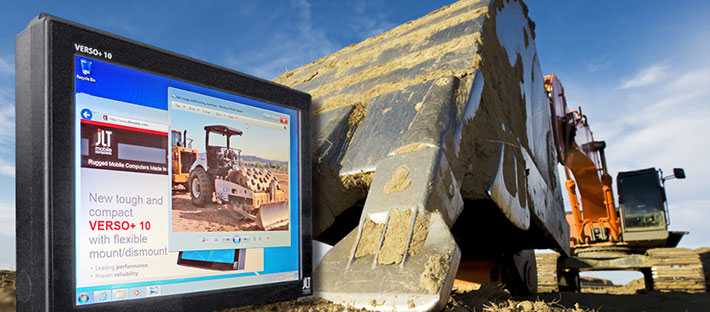
While JLT Mobile is a Swedish company (and, in fact, Sweden's largest PC manufacturer), the company has a global reseller network and also a wholly-owned US subsidiary in Tempe, Arizona. For a number of years, Roper Mobile and then DAP Technologies resold JLT computers, but as of late 2014, JLT took over DAP's vehicle mount operation, staff and facilities and all. That made sense as the US market represents about half of JLT's business, and having a strong local presence in the US is a good thing.
Note right upfront that JLT Mobile is in the high-end rugged mobile PC market, with a strong emphasis on vehicle-mounts. As such, the company is not engaged in duking it out with "white box" generic products, nor engaging in competition with consumer tablets. The sole goal is to design and build the absolute best and toughest vehicle computers, and every single one is manufactured in Sweden.
The VERSO line — high-end quality
With mobile computing becoming more common and more available over the past several years, JLT engaged in a strategic move that would best take advantage of the company's decades' worth of experience in designing and manufacturing rugged computers. The result was the VERSO line introduced in 2013. VERSO represented a conscious shift towards the high-end of the rugged market, one that allowed the company to pursue excellence without compromise.
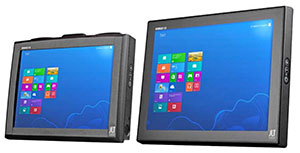 The original two VERSO models (see image to the right) covered the 12-inch and 15-inch display market, both designed to provide reliability and longevity for heavy duty deployments in mining, construction vehicles, off-shore and harbor applications, and agricultural equipment. The original two VERSO models (see image to the right) covered the 12-inch and 15-inch display market, both designed to provide reliability and longevity for heavy duty deployments in mining, construction vehicles, off-shore and harbor applications, and agricultural equipment.
The VERSO+ 10 followed in May 2014 as a reliable, high-performance solution for installations in tight cabins or other small areas where larger panel computers just won't fit.
The new and smaller VERSO+ 10 with its 10.4-inch screen and compact 9.9 x 7.8 inch footprint (barely larger than an iPad) addresses the needs of those who require maximum reliability and functionality in very demanding environments, but in a smaller and lighter package. Like the larger members of the VERSO series, the new model runs on vehicle power and has an internal backup battery good for a few minutes of operation in case of vehicle power issues. All I/O is facing downward for easy, efficient mounting in vehicles or fixed locations. Below is a look at the VERSO+ 10 from the front and from all four sides:
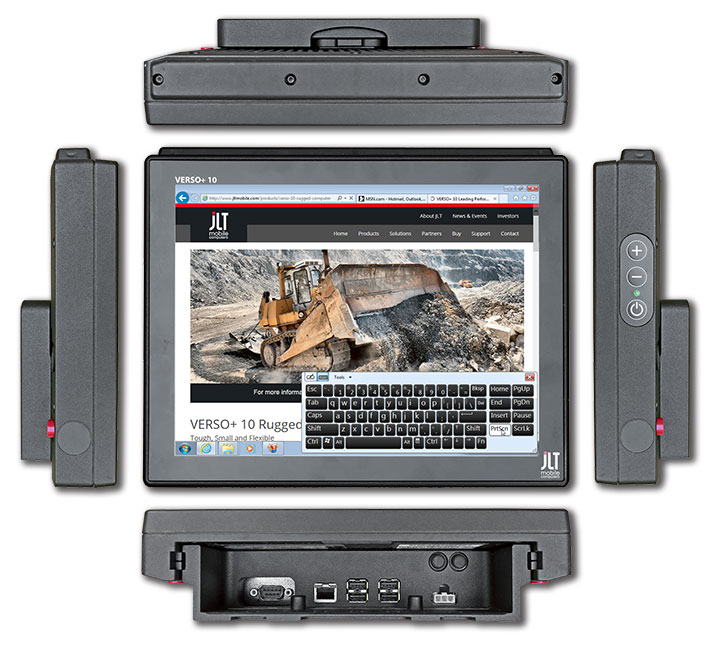
What are the VERSO+ 10's differentiating features? Like other members of the VERSO line, the system feels exceptionally solid and well-made, even compared to other rugged and panel-mount machines. It is also designed for maximum ease-of-use. Apart from a plus and a minus button on the side for brightness adjustment, there aren't any additional controls to figure out and manipulate — it's all done via touch. There aren't any doors and hinges either; all connectors are in one block in the back. The VERSO doesn't need a fan. It therefore operates silently and there's no need to worry about dust or water entering the enclosure through cooling slots.
Performance: two very different chips available
Since they are generally used for specific and well-defined custom applications, rugged vehicle-mount computer like the VERSO+ 10 rarely require the raw computing power of a general-purpose desktop or laptop computer. The device must be quick and responsive enough to get the job done, but not so powerful that heat dissipation and high cost become an issue. Processor experts call this "targeted" performance, i.e. exactly enough performance for a given or anticipated application.
However, high performance may be required and, much to the company's credit, JLT Mobile is making it available via offering two very different chips. Customers can order the VERSO+ 10 either with a rather basic Intel Atom D2550 processor that provides the "targeted" (i.e. exactly as much as needed and no more) jobs performance Intel had in mind when it introduced the Atom platform several years ago. Or they can opt for an entirely more potent Intel Core i5-4300U processor for advanced operations, such as high definition video streaming, GIS calculations, real-time data processing, and so on. By itself, the bare Core i5 chip costs hundreds of dollars more than the Atom D2550. We're talking a BIG difference here.
|
VERSO+ 10 CPU options
|
Core i5
|
Atom
|
|
Model
|
4300U
|
D2550
|
|
Code name
|
Haswell
|
Cedarview
|
|
Introduced
|
Q3/2013
|
Q1/2012
|
|
Cores/Threads
|
2/4
|
2/4
|
|
Lithography
|
22mn
|
32mn
|
|
Base Clock Speed
|
1.90 GHz
|
1.86 GHz
|
|
Turbo Speed
|
2.90 GHz
|
no turbo
|
|
Thermal Design Power (TDP)
|
15 watts
|
10 watts
|
|
Cache
|
3MB Smart Cache
|
1MB L2 cache
|
|
Integrated graphics
|
HD Graphics 4400
|
Intel GMA 3650
|
|
Graphics base speed
|
200 MHz
|
640 MHz
|
|
Graphics max speed
|
1,100 MHz
|
640 MHz
|
|
Memory type
|
DDR3L 1333/1600
|
DDR3 800/1066
|
|
Intel vPro
|
Yes
|
No
|
The table to the right shows some of the pertinent specs of the two processor options JLT offers for the VERSO+ 10. And here's the tale of two chips:
The Intel Atom D2550 is essentially a third generation version of the Atom processors that powered tens of millions of netbooks. "Netbooks" were those ultra-low-cost mini-notebooks that roared in like a lion several years ago and almost equally as quickly vanished when a) people realized you don't get something for (almost) nothing, and b) the iPad and its copies could do the net so much better. In fairness, the D2550 is about 50% faster than those early netbooks and it is perfectly capable of handling many jobs in the field. But it is quite important for customers to determine if it's up to their planned deployment or not.
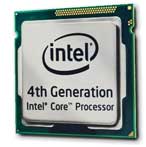 The Intel Core i5 4300U is in an entirely different class. Not only is it a year and a half newer (which is almost an eternity in chip design), but it's a far more complex high-end performance member of Intel's "Haswell" 4th generation of Core processors. Don't be fooled by the two chips' almost identical clock speed of around 1.9GHz. The 4300U can quickly go into "turbo boost" up to 2.9GHz if a task requires it. The D2550 has no turbo. The 4300U also uses more efficient lithography and memory, has three times the cache, has far more powerful integrated graphics, and includes numerous advanced technologies that may or may not be required for certain applications. The Intel Core i5 4300U is in an entirely different class. Not only is it a year and a half newer (which is almost an eternity in chip design), but it's a far more complex high-end performance member of Intel's "Haswell" 4th generation of Core processors. Don't be fooled by the two chips' almost identical clock speed of around 1.9GHz. The 4300U can quickly go into "turbo boost" up to 2.9GHz if a task requires it. The D2550 has no turbo. The 4300U also uses more efficient lithography and memory, has three times the cache, has far more powerful integrated graphics, and includes numerous advanced technologies that may or may not be required for certain applications.
To provide an idea where both VERSO versions fit into the overall computing performance universe we ran our two standard performance benchmark suites on our evaluation VERSO+ 10 with the powerful Core i5 in it. Passmark Software's PerformanceTest 6.1 runs about 30 tests covering CPU, 2D graphics, 3D graphics, memory, and disk and then computes scores for each category and an overall PassMark score. As a cross check, we also always use the CrystalMark benchmark suite that tests various subsystems and then provides an overall score. Since we did not test the VERSO+ 10 with the Atom chip, we listed the results of the D2550-equipped Advantech PPC-3120 industrial Panel PC we tested a couple of years ago. For comparison we're also listing a Logic Supply Cincoze panel that uses the newer quad-core Intel Atom E3845, and a representative of the ultra-rugged tablet genre, the Core i5-4200U equipped Winmate IH83.
The numbers are as follows:
|
JLT Mobile VERSO+ 10 performance in perspective
|
|
PERFORMANCE COMPARISON
|
JLT Mobile
|
Advantech
|
Logic Supply
|
Winmate
|
|
Model
|
VERSO+ 10
|
PPC-3120
|
Cincoze Crystal 15
|
IH83
|
|
|

|

|

|

|
|
Type
|
Fixed-mount PC
|
Industrial Panel PC
|
Industrial Panel PC
|
Rugged Tablet PC
|
|
Year tested
|
2015
|
2013
|
2015
|
2014
|
|
Intel processor
|
Core i5-4300U
|
Atom D2550
|
Atom E3845
|
Core i5-4200U
|
|
Cores/threads
|
2/4
|
2/4
|
4/4
|
2/4
|
|
CPU base speed
|
1.90GHz
|
1.86GHz
|
1.91GHz
|
1.60GHz
|
|
CPU turbo speed
|
2.90GHz
|
no turbo
|
no turbo
|
2.60GHz
|
|
Thermal Design Power (TDP)
|
15 watts
|
10 watts
|
10 watts
|
15 watts
|
|
CPU Mark
|
3,519.7
|
553.8
|
1,951.3
|
2,181.4
|
|
2D Graphics Mark
|
563.6
|
40.1
|
149.0
|
358.0
|
|
Memory Mark
|
1,114.7
|
260.3
|
410.3
|
552.7
|
|
Disk Mark
|
688.5
|
548.0
|
1,417.4
|
2,346.9
|
|
3D Graphics Mark
|
434.1
|
70.9
|
134.4
|
343.5
|
|
Overall PassMark
|
1,419.7
|
320.1
|
921.3
|
1,249.2
|
|
CM ALU
|
44,810
|
12,391
|
25,575
|
26,079
|
|
CM FPU
|
41,133
|
9,289
|
21,647
|
24,628
|
|
CM MEM
|
39,430
|
8,502
|
20,400
|
25,554
|
|
CM HDD
|
16,473
|
9,195
|
31,856
|
44,018
|
|
CM GDI
|
17,630
|
1,878
|
4,856
|
10,696
|
|
CM D2D
|
8,318
|
853
|
3,654
|
4,923
|
|
CM OGL
|
11,951
|
9,319
|
3,311
|
8,134
|
|
Overall CrystalMark
|
179,745
|
51,427
|
111,299
|
144,032
|
By far the most important result here is the vast difference between the Core i5-powered VERSO+ 10 and the Atom D2550-equipped Advantech industrial panel. A VERSO+ 10 with the Atom D2550 would in all likelihood be at roughly the same performance level as the Advantech panel. That means that the overall performance gap between the two VERSO+ 10 processor options is in the 4:1 range. That's massive. It doesn't rule out the D2550 as it may be a perfect fit for many customers. But it may be entirely inadequate for other deployments, and that's why JLT offers also the Core i5.
We included the Logic Supply Cincoze panel because its Atom "Bay Trail" E3845 chip is about as state-of-the-art as it gets in Intel Atom performance in this class. The quad-core Atom E3845 is much quicker than the D2550, but it still doesn't even come close to Intel Core processor performance. That point is emphasized again by the benchmark results of the rugged Winmate tablet. Even though it uses a slower Intel Core chip, it's still much quicker than anything Atom-powered.
Bottomline here: anyone interested in the VERSO+ 10 should not get fixated on the price difference between the two VERSO processor options. The performance difference is so large that it is entirely the job at hand that should determine which CPU option makes the most sense.
Meticulous design and construction
From the first time you look at, and then pick up, the VERSO+ 10, it's obvious that this is a high-end design. Viewed from head-on, the VERSO looks no different from a premium consumer tablet like the iPad, what with its glass surface that covers the entire front except for a very thin bezel that's flush with the glass. But pick up the VERSO and you'll be surprised by the weight of this compact design. We're talking six pounds, which is about as much as six iPad Air 2's stacked on top of each other. It makes no difference as the VERSO is a fixed-mount and won't be carried around, but it provides an idea as to just how solid this device is.
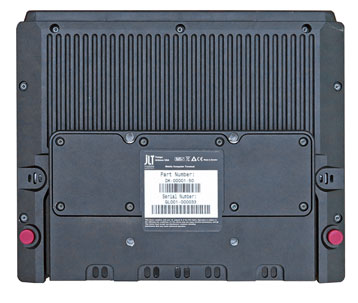 At RuggedPCReview.com we take a peek inside test units whenever possible, to see if inside design and quality match the outside. The housing of the VERSO+ 10 consists of two halves, and then an I/O "bulge" on the back.The first thing you notice on the backside of the VERSO+ 10 is a 1/8-inch aluminum plate covering the I/O of the panel. The plate is securely held in place with eight Torx 10 screws. Sealing is via a rubber pressure seal. At RuggedPCReview.com we take a peek inside test units whenever possible, to see if inside design and quality match the outside. The housing of the VERSO+ 10 consists of two halves, and then an I/O "bulge" on the back.The first thing you notice on the backside of the VERSO+ 10 is a 1/8-inch aluminum plate covering the I/O of the panel. The plate is securely held in place with eight Torx 10 screws. Sealing is via a rubber pressure seal.
Inside the I/O bay is an I/O board which technically is on the outside of the sealed computer housing itself. Sealing multiple I/O ports against liquids and dust intrusion is a notoriously difficult task in rugged mobile computer systems. JLT's solution means they only have to seal the point where the various I/O cables go inside the housing, and not every connector separately. This makes for a better protected devices, and also makes it easy to replace the I/O module, or offer different I/O modules and perhaps even customized I/O. The I/O box itself is sealed, too, of course, and that's made easier by having all I/O cables going in the same direction (down).
The VERSO+ 10 essentially consists of two parts. There's the body part with the system board, speakers, and battery inside, and he I/O board outside. And there's the front side with the touch display and the touch controller.
The two parts are held together via ten Torx 10 screws. Sealing is accomplished via a modified tongue-and-groove design where the removable and replaceable pressure seal runs along the perimeter of the display part of the panel. Three easy-to-connect multi-wire cables run between the two halves. Below you can see the inside of the JLT VERSO+ 10:
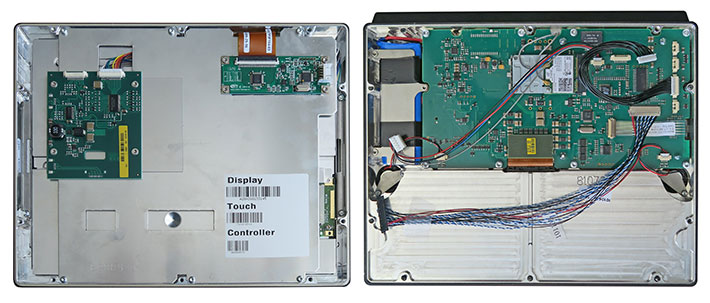
The inside of the VERSO+ 10 is a sight to behold. There are no plastic parts anywhere. Something needs to be fastened? That's done either with a Torx 8 or 9 screws, or there's a specially machined metal retainer or bracket plus Torx screws. 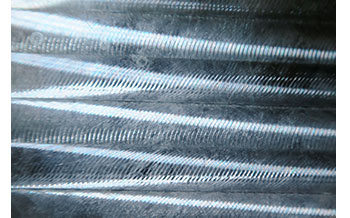 Both the top and the bottom of the device seem to be machined from solid blocks of aluminum. Both the top and the bottom of the device seem to be machined from solid blocks of aluminum.
The milling process is incredibly precise, even in the many rounded and angled parts of the design, and beautifully finished. All edges and corners are smoothed. Surfaces are milled smooth with machining tracks and surface quality reminiscent of a sparkling ice hockey rink just after the Zamboni has finished its work and the ice is ready for the next period.
The display half of the VERSO+ 10 is as meticulously engineered and manufactured as the system half. Controller boards are mounted not simply onto the LCD, but onto their own separate metal plate. There are no plastic parts. Everything is secured with Torx screws. And there is a sticker that shows the bar codes for the display, touch sensor and controller, so that service technicians can easily look up the exact parts used in a device.
There's an Intel Dual Band Wireless-AC 7260 half-size miniPCIe module. This being a JLT design, the module isn't simply inserted or perhaps screwed down. No, there's a specially made spring-loaded module extension piece that presumably provides even greater protection against damage from vibration.
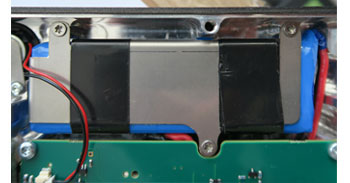 As one would expect from a vehicle-mount computer, the VERSO+ 10 has robust power management. That includes an uninterruptible source of backup power in the form of a small internal battery that's good for a few minutes. This means the system is immune to most external power glitches. As one would expect from a vehicle-mount computer, the VERSO+ 10 has robust power management. That includes an uninterruptible source of backup power in the form of a small internal battery that's good for a few minutes. This means the system is immune to most external power glitches.
If you look at the power specs, you see that the VERSO+ 10 can handle a wide input power range from 9 to 36 Volts DC. That's to match the large power range available in today's heavy machinery.
The backup battery measures about 3.6 x 1.25 inches and is half an inch thick. It's one of those blue-wrapped unmarked designs often found in electronics. It's held in place by a metal retainer with three screws. It's replaceable by a service department.
We did not remove the motherboard so as not to disturb the thermal transfer material that is between the CPU and ancillary circuitry, and the heavy aluminum body of the VERSO+ 10 that serves as a heat spreader and heat sink.
Most devices with a processor as powerful as this Core i5-equipped VERSO must rely on a fan for cooling. But a fan is definitely not desirable in the almost invariably dusty working environments this computer is designed for, and so the VERSO dissipates heat through its heavy housing. It does get quite warm, but that's rarely an issue for a device that's mounted in heavy machinery such a bulldozers, cranes and such.
Finally, below, some details. From left to right, the meticulously milled bedding for the internal speaker that's then held in place with its own little metal bracket, the easily replaceable I/O module that allows for easy customization, and the rubber seal that runs around the perimeter of the device between its two housing halves.

Numerous mounting options
Unlike laptops that sit on a desk or lap, and tablets that are held, vehicle-mounts must be able to be secured in a vast variety of different vehicles with vastly different layouts and mounting possibilities.
With the JLT VERSO+ 10, mounting is via standard VESA mount, with the 3 x 3 inch (75 x 75 mm) square screw pattern. A large variety of mounting solutions are available from RAM Mounts, including an H-plate mount, a lift truck overhead guard mount, a No-Drill vehicle mount, as well as locking or standard RAM Ball Mounts in a variety of diameters and lengths.
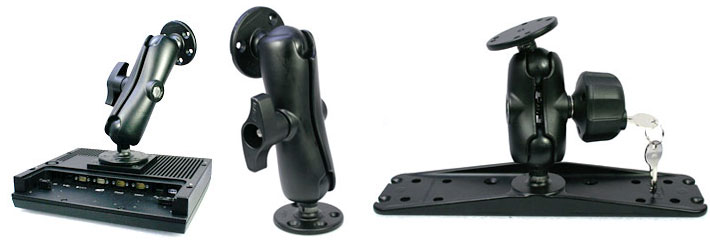
For applications that require a keyboard for rapid data entry there are NEMA4-sealed iKey keyboards, and there's also a variety of bare leads and quick-connect cables for installation, and more.
Display
Desktop and, for the most part, laptop displays have it easy as they generally do not have to deal with constantly changing lighting conditions. The situation is very different for vehicle-mounts where operating conditions may range from near complete darkness all the way to direct blazing sunlight. That requires a display that can handle those conditions, as well as all the physical abuse inherent to vehicle mounts.
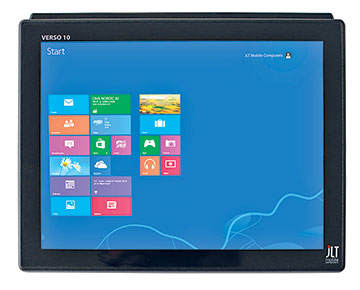 The VERSO+ 10 has such a display. It's an industrial-grade 10.4" 1024 x 768 pixel IPS LCD from NLT Technologies, a Japanese company specializing in advanced liquid crystal display solutions for industrial applications. JLT offers two versions of the display, one with 400 and the other with 800 nits luminance (presumably the NLT NL10276BC20-18F (800 nits) and the NL10276BC20-18D (400 nits)). The brighter screen's power draw is 7.5 watts, whereas the 400 nits display uses 4.8 watts. The VERSO+ 10 has such a display. It's an industrial-grade 10.4" 1024 x 768 pixel IPS LCD from NLT Technologies, a Japanese company specializing in advanced liquid crystal display solutions for industrial applications. JLT offers two versions of the display, one with 400 and the other with 800 nits luminance (presumably the NLT NL10276BC20-18F (800 nits) and the NL10276BC20-18D (400 nits)). The brighter screen's power draw is 7.5 watts, whereas the 400 nits display uses 4.8 watts.
The screens offer a viewing angle of 160 degrees both horizontally and vertically. That's not the almost full 180 degree angles we consider desirable for tablets, but it's more than acceptable in a fixed mount product that will be mounted in a position where the operator can easily view it.
Industrial and sunlight-viewable displays always offer some secret sauces to increase their performance, and the display used in the VERSO+ 10 is no different. According to NLT, the screen's SFT (Super Fine TFT) technology is designed to reduce the variance in brightness and color when the display is viewed from various angles. NLT also refers to their special T-EVT "Transmissive-Enhanced View Technology" that combines a strong backlight for good viewability in weak lighting conditions, and advanced surface reflection control for use in daylight and bright lighting conditions. For a description of NLT's products and technologies, see here.
Screen brightness can be adjusted from off to 100% in 15 steps via the + and - buttons on the side.
As far as resolution goes, in this day and age of smartphones with full 1920 x 1080 pixel 1080p or even 4k resolution, 1024 x 768 pixel XGA may no longer seem like a lot. But consider that 1024 x 768 is what tens of millions of iPads and iPad 2s had and no one ever complained about their resolution. And the VERSO's 125 dots per inch are quite a bit sharper than the 109 dpi of the big iMac27 I am writing this review on. In addition, over the years most vertical market applications have been written and optimized for XGA.
Capacitive multi-touch
Note one substantial change from JLT's other panel computers: instead of a resistive touch screen, the VERSO+ 10 uses projected capacitive multi-touch. Capacitive multi-touch touch is the technology popularized first by the iPhone and then the iPad. It allows the effortless tapping, swiping, pinching and zooming used by virtually all consumer smartphones and tablets today.
Capacitive touch took a lot longer to become accepted in vertical market products, for a variety of reasons. One was that classic Microsoft Windows, designed for use with a mouse or a point stylus, never worked well with just tapping a finger on all of Windows' tiny check boxes, scrollers, and pulldown menus. Another was that standard capacitive touch doesn't work with gloves on or in the rain. And in the field it often does rain, and workers are wearing gloves.
So why did JLT decide to use capacitive touch in the VERSO+ 10? Most likely because capacitive touch works very well with the kind of touch-optimized custom applications that are commonly used in vehicles. Think how well bank ATMs work with touch, and they all use capacitive touch.
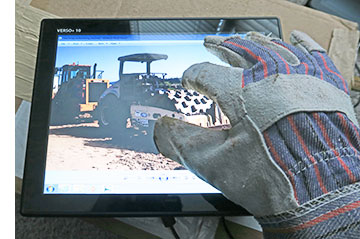 But what about gloves? Vehicle operators often wear gloves. Well, there have been substantial advances in capacitive touch technology (see RuggedPCReview's Advances in capacitive touch and passive capacitive pens) and capacitive touch can now support use with gloves. In our tests, the VERSO+ 10 display can be operated even with thick gloves on (see picture to the right). But what about gloves? Vehicle operators often wear gloves. Well, there have been substantial advances in capacitive touch technology (see RuggedPCReview's Advances in capacitive touch and passive capacitive pens) and capacitive touch can now support use with gloves. In our tests, the VERSO+ 10 display can be operated even with thick gloves on (see picture to the right).
And what about use in the rain? That's a bit more difficult to handle for capacitive displays, as the standard technology used is inherently unable to handle wetness. There are emerging solutions to the wetness issue, but in vehicle-mounts, wetness is much less of an issue than gloves.
Overall, capacitive touch is a perfect solution for in-vehicle fixed-mount computers where the emphasis is on effortless, reliable operation of touch-optimized software. Add to that the superior scratch and damage resistance of capacitive displays and the ease with which the flush front of the VERSO+ 10 can be wiped off and kept clean, and JLT's choice makes a lot of sense.
For those to whom it may matter: whereas Microsoft generally requires 10-point multi-touch, the VERSO+ 10 display seems limited to two points. That's sufficient for virtually all touch operations, but some gestures require more.
Operating systems
JLT Mobile can ship the VERSO+ 10 with a variety of different operating systems. Those include Windows 7 Professional, Windows Embedded Standard 7, and Windows Embedded 8.1 Industry Pro. Of each of these, systems equipped with the Core i5 processor use the 64-bit version whereas those running on the Atom D2550 use the 32-bit version. Which is best? That depends entirely on the intended application.
 Our evaluation machine came with Windows 7 Professional, but many units will undoubtedly be ordered with Windows Embedded Standard 7 or Windows Embedded 8.1 Industry Pro. This requires a bit of explanation which those who are familiar with embedded operating systems can skip: Our evaluation machine came with Windows 7 Professional, but many units will undoubtedly be ordered with Windows Embedded Standard 7 or Windows Embedded 8.1 Industry Pro. This requires a bit of explanation which those who are familiar with embedded operating systems can skip:
A general purpose OS, like Windows 7 Professional, is just that, general purpose. You can do anything you want with it, and run anything you want on it. With that in mind, Microsoft equipped its consumer and enterprise Windows versions with all the drivers and software and utilities one could possibly need. The result is a rather large OS with numerous processes and services running all the time, all consuming storage, memory and power.
An embedded operating system is totally different. The idea is to only use what you need to perform a certain task and leave everything else behind. This greatly reduces the size of the operating system and dramatically reduces hardware requirements. Windows Embedded Standard 7, for example, is generally used for smart, connected and service oriented commercial and industrial devices that do not need all of Windows 7, yet can still run thousands of existing Windows applications. A minimum bootable image of Windows Embedded Standard 7 is just 300MB, a fraction of what full Windows 7 Professional takes.
Embedded operating systems are not one-size-fits all. A company will determine exactly what a machine is for and what it should be able to do. They then include as many components (hence the term "componentized" operating system) as they need. There are over 10,000 available and it's easy to create lean, nimble embedded OS platforms that can still do sophisticated high level tasks like advanced multimedia, browsing, communications or whatever a task requires. An embedded OS can even run as a real-time OS via third party plug-ins. Essentially you get the power of the basic Windows engine, but without any overhead you don't need.
Note that configuring and building an embedded Windows image requires considerable expertise. JLT Mobile has been dealing with embedded versions for a long time and can develop and manage customer images.
Ruggedness
The JLT VERSO+ 10 is a fully rugged machine designed to easily hold up to rough handling and demanding environmental conditions. The heavy-duty aluminum housing is just about invulnerable. Note that ruggedness characteristics of a vehicle-mount are inherently different from those of a rugged mobile system. Vehicle-mounts aren't carried around and thus can't be dropped. They are, however, subjected to much more vibration and shock.

The environmental spec sheet of the VERSO+ 10 is quite impressive. The machine has an extremely wide operating temperature range of -22 to 131 degrees Fahrenheit, which means it can be operated in freezers and on other assignments where it will encounter freezing temperatures. Since the VERSO+ uses a solid state disk and not rotating media, it can easily meet and exceed many MIL-STD-810G specified procedures.
Water and dust protection is at the IP65 equivalent, where the 6 stands for total protection against dust, and the 5 for protection against low pressure jets of water from all directions. Note that the exact degree of ingress protection depends on the type of mounting and that connector sealing may be required.
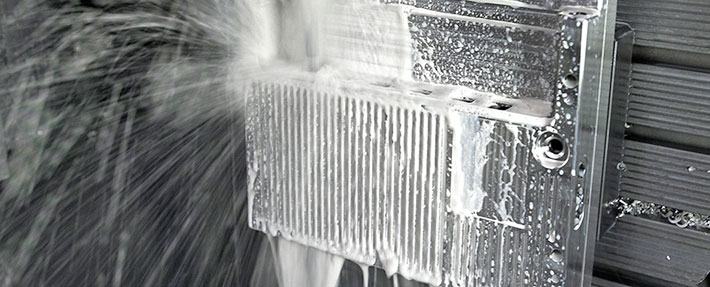
The machine can handle 10 - 95% humidity; three hours worth of 5 - 500 Hz/4.5 g RMS and survive 30 g of shock for 11 milliseconds. Do realize that shock and vibration resistance are the most important ruggedness criteria for a vehicle-mount system. And also that proper mounting is of crucial importance in minimizing the overall potential for damage in a vehicle-mount.
The JLT Mobile VERSO+ 10: bottom line
The VERSO+ 10 is the latest addition to a line of rugged and highly configurable vehicle-mount and fixed-mount computers made by one of the most respected manufacturers in the business. The platform was designed from the ground up for ease-of-use and the ability to hold up in a variety of demanding vehicle applications in mining, ports, yard-logistics, freezer storage, forestry, agriculture and more. 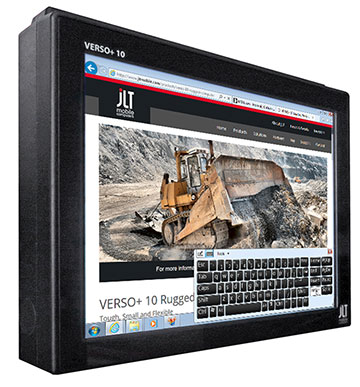 With a footprint barely larger than that of an iPad, the VERSO+ 10 addresses the needs of those who require maximum reliability and functionality on the job, but in a small and compact package. The attractive and very solid matte-black housing with a durable powdercoat finish is made of aluminum and should withstand even the roughest handling. With a footprint barely larger than that of an iPad, the VERSO+ 10 addresses the needs of those who require maximum reliability and functionality on the job, but in a small and compact package. The attractive and very solid matte-black housing with a durable powdercoat finish is made of aluminum and should withstand even the roughest handling.
Designed to run a very wide variety of applications, the VERSO+ 10 is available with a modest Atom processor for simple operations, but also with a much higher performance Intel "Haswell" Core i5 CPU that can handle anything. The device is so well thermally managed that it does not need a cooling fan even with the powerful Core processor. The VERSO+ 10 uses reliable CFast solid state storage and there is no hard disk. Performance depends on your choice of operating system. Our Windows 7-based test unit was very quick and responsive.
The 10.4" display is bright and has a very responsive capacitive multi-touch screen that even works with thick gloves. Our test unit had the optional 800 nits luminance display (400 nits is standard) that easily allows the unit to be used broad daylight. The display can be adjusted from off all the way to full power.
The VERSO+ 10 is a very rugged unit that is very well sealed against dust and, if properly mounted, can also handle water jets from all directions. It has an exceptionally wide operating temperature range (-22 to 131 degrees Fahrenheit) and you generally never have to worry about it getting damaged.
The machine offers good connectivity via four USB 2.0 ports, a LAN port, and a legacy serial port, all located in the back of the unit, facing down. There is dual-band 801.11ac WiFi and integrated Bluetooth, as well as dual-diversity antennas for optimal reception even in locations with a weak signal. The VERSO+ 10 uses external vehicle power, but also has a small internal UPS backup to guard against power fluctuations.
Overall, this exceptionally well-made machine is designed for reliable operation in vehicle and other fixed-mount locations in a very wide range of applications. A most impressive product indeed.
-- Conrad H. Blickenstorfer, August 2015
JLT Mobile Computers VERSO+ 10 Specs:
| Added/changed |
Added 05/2014, updated 01/2015, full review 08/2015
|
| Type |
Rugged fixed-mount computer
|
| Processor |
1.9/2.9GHz Intel Core i5-4300U
1.86GHz Intel Atom D2550
|
| Processor clock speed |
Intel Core i5-4300U: 1.9/2.9GHz
Intel Atom D2550: 1.86GHz |
| Processor TDP speed |
Intel Core i5-4300U: 15 watts
Intel Atom D2550: 10 watts |
| Graphics |
Intel Core i5-4300U: Intel HD Graphics 4400
Intel Atom D2550: Intel integrated |
| OS |
Intel Core i5-4300U: Windows Embedded Standart 7 64-bit, Windows 7 Pro 64-bit, Windows 8.1 Industry Pro 64-bit
Intel Atom D2550: Windows Embedded Standart 7 32-bit, Windows 7 Pro 32-bit, Windows 8.1 Industry Pro 32-bit
|
| Standard/Max RAM |
Intel Core i5-4300U: 8GB DDR3
Intel Atom D2550: 4GB DDR3 |
| Disk/drive |
CFast SATA 16GB/64GB/128GB |
| Display type |
IPS TFT with anti-reflective coating, Gorilla glass 3 protection, 80/80/80/80 degree viewing angle |
| Display size/resolution |
10.4"/1024 x 768 pixel XGA (400 or 800 nits); NLT Technologies NL102676BC20-18C or 18F |
| Digitizer |
Projected capacitive 2-point multi-touch |
| Keyboard/keys |
Onscreen
|
| Navigation |
Touch
|
| Expansion slots |
1 x miniPCIe, 1 x SIM
|
| Housing |
Aluminum
|
| Size |
9.9 x 7.8 x 2.5 inches (251 x 198 x 63 mm)
|
| Weight |
6.0 lbs. (2.7kg)
|
| Operating temperature |
-22° to 131°F (-30° to 55°C) |
| Ingress protection |
IP65 - IEC 60529:2001 (totally dustproof, sealed against low pressure water jets from all directions) |
| Humidity |
10-95% RH |
| Shock |
30g for 11ms XYZ - IEC 60068-2-27 |
| Vibration |
5-500 Hz/0,04 m/s2 XYZ - IEC 60068-2-64 Fh |
| Altitude |
810G in applicable areas |
| ESD |
Unknown |
| Power |
9-36 VDC unisolated, internal battery backup |
| Camera |
None |
| Communication |
Dual-band 802.11ac WiFi, Bluetooth v4.0, WLAN dual diversity antennas; optional: EDGE/HSPA+, A-GPS in dock
|
| Interface |
4 x USB 2.0, 1 x RS232 w/ 12V, waterproof stereo speakers, HD audio
|
| Price |
Inquire |
| Spec sheet |
 JLT VERSO+ 10 brochure (PDF) JLT VERSO+ 10 brochure (PDF)
|
| Web page |
JLT VERSO+ 10 web page |
| Contact |
 JLT Mobile Computers AB
JLT Mobile Computers AB
Isbjoernsvaegen 3
SE-352 45 Vaexjoe, Sweden
Phone: +46 470 53 03 00
Fax: +46 470 445 29
info at jltmobile.com
Web: www.jltmobile.com
|
 JLT Mobile Computers, Inc.
JLT Mobile Computers, Inc.
8945 South Harl Ave, Suite 112
Tempe, Arizona 85284, USA
Phone: +1 480 705 4200
Fax: +1 480 397 1214
USsales at jltmobile.com
Web: www.jltmobile.com
|
|




